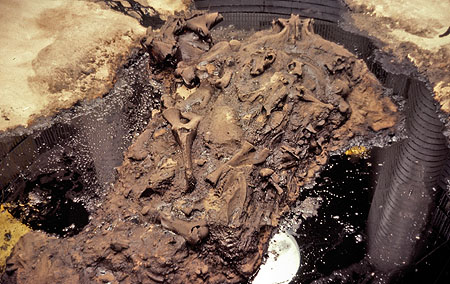![]()
What you must do in this unit
- Read chapter 1 in the textbook. Remember in this unit of the course, we are focusing on pre-history. That means the time before urban civilization developed, i.e. before 3000 BCE. Students often have asked me about the purpose of the textbook in the course. Let me offer two points. 1st, we can't cover everything in world history, and so the textbook helps provide the linking material between the topics that we cover in each unit. The textbook also offers information about each of the topics that we do cover in the course. 2nd, the textbook is a good starting point to help you answer the key terms and questions to consider for each unit of the course. And finally, 3rd, the textbook is a big help in studying for the timeline on the final exam, and also for the maps on both exams.
- Read my Pre-History Notes and watch my short video on pre-history.
- Study the Questions to Consider and the Key Terms for the Unit.
- Submit the Required Pre-History paragraph (50 points).
What you should do in this unit
- Check out some Example Assignments and Sample Test Items so you have a good idea of the kind of assignments in the course.
- Confused about dates? Have a look: What do bp, bc, bce, ad, ce, and cal mean?
What you can do in this unit
- Read Professor Campbell's notes on The Origins of Religion.
- Read Mark Kane's information about prehistoric Stone Circles.
- Listen to some further information for this unit as a mp3 file. You can also read the information as a txt file.
Some videos that you can watch for this unit
- And Man Created Dog: A National Geographic Presentation (This may, or may not, be available somewhere on the web.)
- Guns, Germs, and Steel
- Yuval Noah Harari, What Explains the Rise of Humans?
- The Agricultural Revolution: Crash Course World History #1
- The Oldest Enigma of Humanity (about earliest cave paintings)
- Cave Of Forgotten Dreams by Werner Herzog (official trailer) For a review of the film, with video commentary by Herzog, see here.
- Stories From the Stone Age - 1 of 15
- Cosmological Time Scale 1
- It's not really a video, but Civilizations is a kind of interactive timeline of world empires.
- For extra credit please suggest to your instructor a relevant video for this unit of the course. Send the title of the video, the URL and a brief explanation of why you find the video interesting and applicable to the material that is being studied in this unit.
Extra Credit Options
- For up to 25 points of extra credit, write a one-page paper, How did the work of Mary Leakey contribute to our knowledge of early hominids and an understanding of human evolution?
- For extra credit, please suggest a relevant website for this unit of the course. Send your instructor the title of the site, the URL and a brief explanation why you find the information interesting and applicable to the material being studied this unit.
Unit Learning Objectives
- Upon successful completion of this unit, you will be able to (1) demonstrate knowledge of the key phases in the development of prehistorical society.
